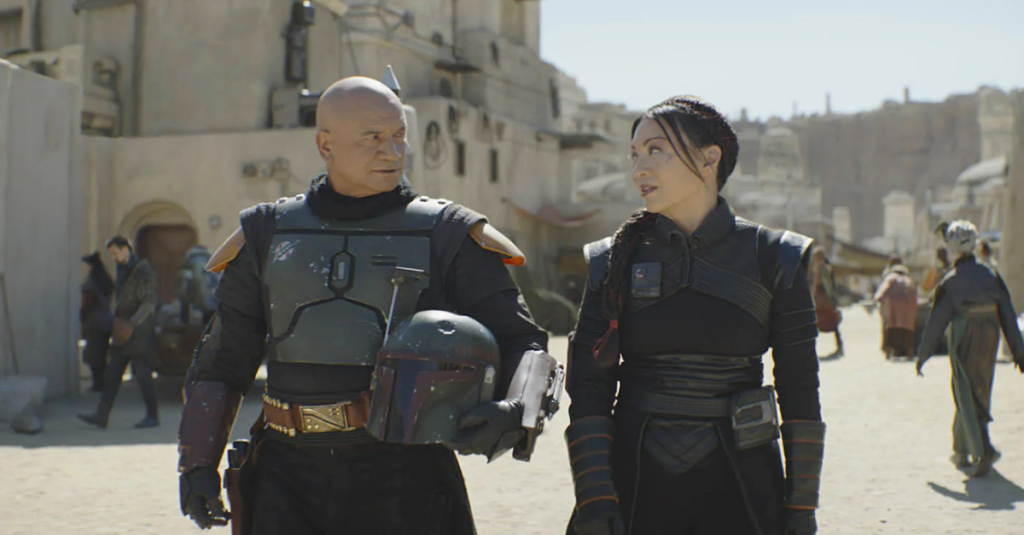At my Star Wars: Revenge of the Sith screening this past weekend, something remarkable happened: right after the 20th Century Fox/Lucasfilm logos lit up the screen, that familiar “a long time ago, in a galaxy far, far away…” blue text filled up my eyes and then brief darkness. Suddenly! That booming John Williams theme filled up the auditorium, and the Star Wars logo raced by. In that moment, all of the weird stuff now attached to this saga disappeared. All the internet toxicity, the crummy streaming shows, and whatever was going on with The Rise of Skywalker and the Sequel Trilogy… None of it mattered.
Videos by ComicBook.com
That grandiose opening for Star Wars movies does such an excellent job of immediately immersing you into its world and promising you something special is on its way – it’s also something that works especially well in a theater. Your line of sight is filled exclusively with this saga’s trademark onscreen text while speakers covering every inch of the auditorium’s walls submerge viewers in that iconic score. With all due respect to Star Wars: Andor and its terrific second season, being reminded of the tremendous power of this opening in a theatrical environment made one thing clear than ever. As Kylo Ren might say, “Let Star Wars on TV die. Kill it if you have to.”
Star Wars Doesn’t Belong on The Small Screen

George Lucas spent years in the late 2000s trying to get a live-action Star Wars program off the ground called Star Wars: Underworld; ultimately, the production went nowhere. Lucas couldn’t figure out how to make the Star Wars Universe work within the budgetary and scope restrictions of television; Disney’s solution to this was just to throw endless gobs of money at Disney+ shows set in this cosmic realm. The two Andor seasons had a combined budget of over $600 million, for example. The results of all that money make Underworld’s demise a blessing in disguise.
Save for Andor and The Mandalorian’s first season, the TV side of Star Wars has become a vessel for suffocating fan-service and weirdly paced productions like Obi-Wan Kenobi, stretching out the content of one movie into six hour-long episodes. Exorbitant budgets can’t mitigate the distractingly cheap aesthetics underpinning projects like Obi-Wan and The Book of Boba Fett, which undercut the grandeur and impressive tactility one associates with Star Wars. These are supposed to be rich universes one can step right into, not projects where one can immediately discern the limitations of shooting on StageCraft soundstages.
More distressingly, the very method of weekly episodes dilutes the special nature of Star Wars. This franchise used to be defined by only getting trotted out once every three years. Even the initial Disney Star Wars pattern of a single feature a year still had a sense of uniqueness to it. Audiences would get to wait all year for a grand new Star Wars adventure in the holiday season. With the streaming shows, Star Wars just became another thing airing in chunks on Tuesday nights – content you could put on as background noise while scrolling through your phone.
Andor Season 1, Obi-Wan Kenobi, and all but one of The Book of Bob Fett episodes all dropped in 2022, emphasizing the height of Star Wars’ oversaturation problem. Considering Obi-Wan and Andor dropped multiple episodes at once for their respective premieres, there were 21 weeks out of the year where viewers got episodes of live-action Star Wars storytelling. That’s nearly every other week! How can Star Wars be special if audiences are getting so much of it at once?
[RELATED: You’ll Never Believe The Lowest-Grossing Skywalker Saga Movies]
Star Wars Hasn’t Done Well With Live-Action TV

The era of live-action Star Wars television would be easier to digest if it actually leaned into the unique and exciting traits of long-form television storytelling. Instead, this production (save for Andor and Mandalorian Season 1) has just leaned into making bloated movies that get divided up into poorly paced segments. Even a show rife with potential like The Acolyte started off with two humdrum episodes, wasting a tremendously detailed Amandla Stenberg performance on episodes that were impossible to tell apart.
It was all just one long strand of storytelling instead of exciting standalone outings. Ironically, the greatest TV shows of all time, like The Sopranos or Breaking Bad, were masters at the art of standalone episodes. People still talk about installments like “the one with Walter White and the fly,” or “the one with Christopoher and Paulie in the snowy woods,” years after their respective airdates, because they were concerned with telling one good story in the here and now. They weren’t just servicing a larger storytelling canvas at the expense of immediately satisfying narratives.
Unfortunately, the Star Wars shows have largely come from feature film or animated television veterans unfamiliar with how to properly execute televised storytelling. If the deluge of Star Wars Disney+ programming was up to par with Andor, then maybe live-action Star Wars TV productions could continue. However, that excellent Tony Gilroy production is clearly an outlier. Instead, the era of live-action Star Wars TV shows has largely accomplished the magical hat trick of diluting the specialness of Star Wars movies and wasting the potential of great television – not to mention stepping on grounds that the Star Wars Animated Universe (Clone Wars, Rebels, The Bad Batch) has spent years building up, when the franchise was otherwise stalled (the early 2010s).
Star Wars on the big screen won’t produce exclusively cinematic bangers, as The Rise of Skywalker, The Phantom Menace, and Attack of the Clones can attest. Still, isn’t an occasional two-hour misfire preferable to cranking out multiple exceedingly costly six-or-seven-hour-long drags? Plus, at least those big-screen boondoggles existed in the confines where Star Wars was born and thrives best; this was a franchise that was meant to dazzle your full attention on the big screen and inspire awe with its scale. Reducing Star Wars to just being a bunch of streaming thumbnails is a cruel joke. With apologies to Mr. Cassian Andor, it’s time for live-action Star Wars media to exclusively return to the pop culture “high ground” of movie theaters. Killing younglings is bad, but killing Star Wars live-action television would be a mercy.
Andor Season 2 is currently dropping new episodes on Tuesdays on Disney+.








